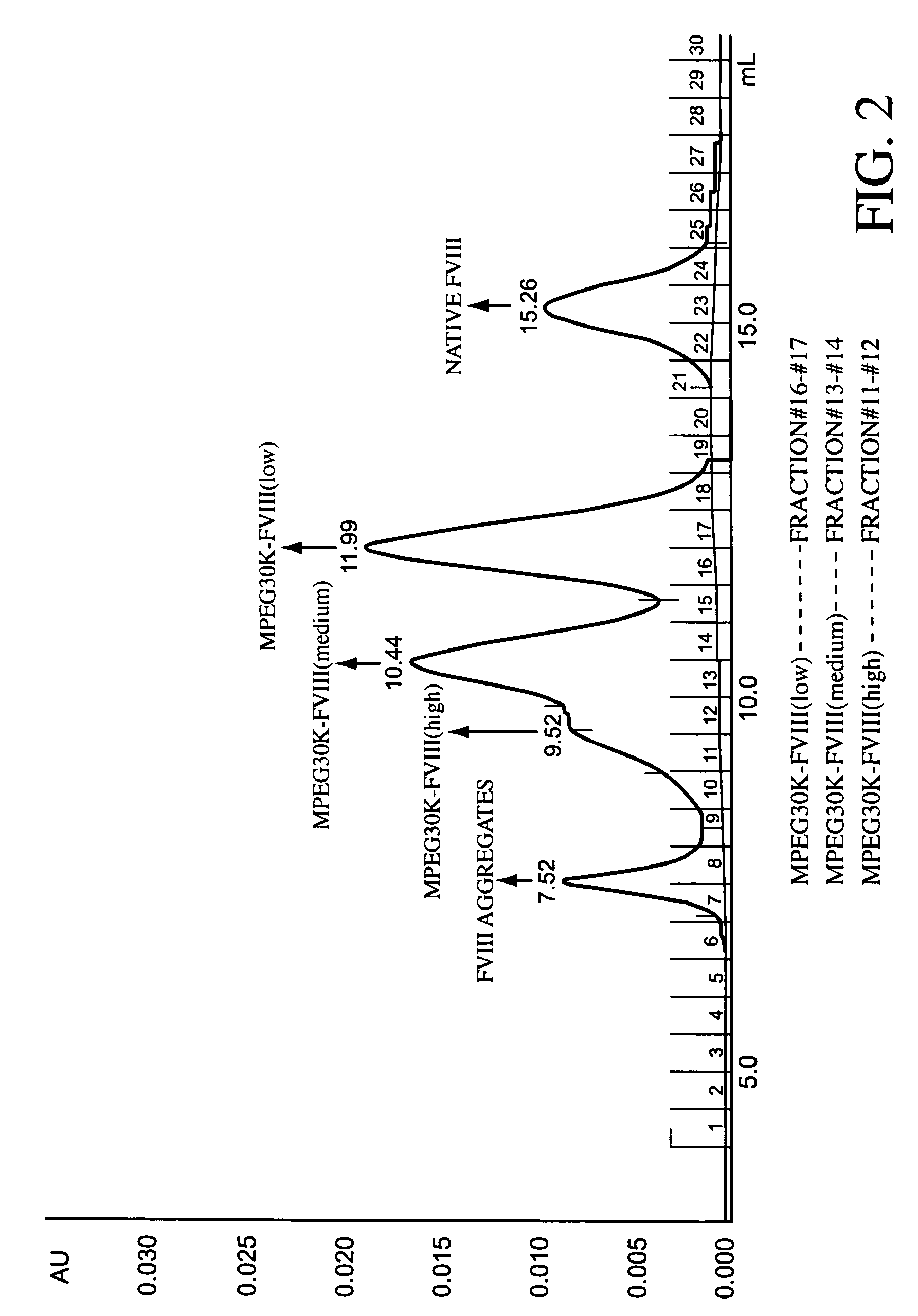Polymer-factor VIII moiety conjugates
a technology of polymer-factor viii and conjugates, which is applied in the field of conjugates, can solve the problems of inability to effectively form blood clots that serve to stop blood loss, inability to produce effective amounts of one or more substances, and relatively large amount of thrombin over time, so as to reduce immunogenicity, reduce the frequency of dosing, and reduce the effect of dosing frequency
- Summary
- Abstract
- Description
- Claims
- Application Information
AI Technical Summary
Benefits of technology
Problems solved by technology
Method used
Image
Examples
example 1
PEGylation of B-domain Deleted Factor VIII with mPEG-SPA, 20K
[0220]mPEG-Succinimidyl propionate having a molecular weight of 20,000 Daltons is obtained from Nektar Therapeutics, (Huntsville, Ala.). The basic structure of the polymer reagent is provided below:
[0221]
[0222]B-domain deleted Factor VIII is dissolved in deionized water, to which is added triethylamine to raise the pH to 7.2–9. To the above solution is added a 1.5 to 10-fold molar excess of the PEG reagent, mPEG-SPA. The resulting mixture is stirred at room temperature for several hours.
[0223]The reaction mixture is analyzed by SDS-PAGE to determine the degree of PEGylation of the protein. The degree of PEGylation, 1-mer, 2 mers, etc., can also be determined by any of a number of analytical techniques appropriate for proteins of this size, such as light angle scattering. The displayed peaks for native and mono-PEGylated species differ by approximately 20,000 Da. Increasing the ratio of PEG reagent to protein increases the ...
example 2
PEGylation of B-Domain Deleted Factor VIII with mPEG-SBA
[0224]mPEG-Succinimidyl butanoate having a molecular weight of 10,000 daltons is obtained from Nektar Therapeutics, (Huntsville, Ala.). The basic structure of the polymer reagent is provided below:
[0225]
[0226]B-domain deleted Factor VIII is dissolved in deionized water, to which is added triethylamine to raise the pH to 7.2–9. To this solution is then added a 1.5 to 10-fold molar excess of mPEG-SBA. The resulting mixture is stirred at room temperature for several hours.
[0227]The reaction mixture is analyzed by SDS-PAGE to determine the degree of PEGylation of the protein.
example 3
PEGylation of B-Domain Deleted Factor VIII with mPEG-MAL, 20K
[0228]mPEG-Maleimide having a molecular weight of 20,000 daltons is obtained from Nektar Therapeutics, (Huntsville, Ala.). The basic structure of the polymer reagent is provided below:
[0229]
[0230]B-domain deleted Factor VIII is dissolved in buffer. To this protein solution is added a 3–5 fold molar excess of mPEG-MAL. The mixture is stirred at room temperature under an inert atmosphere for several hours. The reaction mixture is analyzed and purified by HPLC to provide a mixture of conjugated species.
PUM
| Property | Measurement | Unit |
|---|---|---|
| Mass | aaaaa | aaaaa |
| Mass | aaaaa | aaaaa |
| Mass | aaaaa | aaaaa |
Abstract
Description
Claims
Application Information
 Login to View More
Login to View More - R&D
- Intellectual Property
- Life Sciences
- Materials
- Tech Scout
- Unparalleled Data Quality
- Higher Quality Content
- 60% Fewer Hallucinations
Browse by: Latest US Patents, China's latest patents, Technical Efficacy Thesaurus, Application Domain, Technology Topic, Popular Technical Reports.
© 2025 PatSnap. All rights reserved.Legal|Privacy policy|Modern Slavery Act Transparency Statement|Sitemap|About US| Contact US: help@patsnap.com



